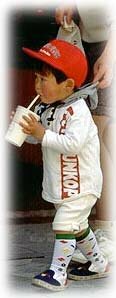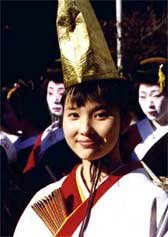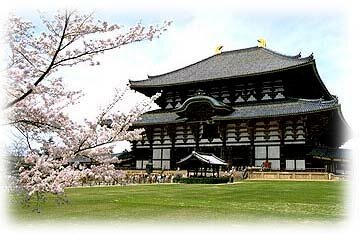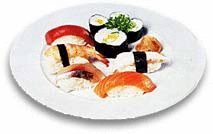
Our Japanese course in Japan (see below)
- Tokyo
125,1 millions
 National Anthem National Anthem
Weather
Japanese and English.
- Voltage : 110V
- Driving: on the left
Yen
Canadians can consult this site: information site for better traveling (for Canadian nationals). For nationals of other countries, please address yourself to the embassy or the consulate of China in your own country.
In Tokyo, electronics is king. We can also find fine papers of all kinds, brushes with hairs of otter and ballot boxes of temple to burn the incense. The temple bells made of bronze are proposed in all formats. Lacquers, rods, teapots and combs constitute beautiful memories. The silk kimonos and the cotton yukatas are always delicately decorated. Many accessories of the ceremony of the tea point out the long tradition of Japan. Eventails, paper lamps, waxed paper umbrellas and stag-wheels make also marvelous purchases. At the entry of the temples, we may find many fine papers calligraphed by Buddhist priests and shinto´sts, that pledge longevity, fertility and success.
Delicious Sushi Recipe
Time for preparation: 10 min
Preparation of the sushi:
- Wash 3 rice cups (short grain) with cold water and let it drain for 1 hour;
- Then, put the rice in a pan
- pour 1 liter of water
- let it boil to average fire
- cover and cook with sharp fire for 2 min.
- reduce fire to the minimum and then continue cooking 20 min.
- open
- deposit a linen on rice
- close again and let rest 15 min.
- In a small pan, pour 6 C of rice vinegar table; with 5 table spoons of sugar and 4 tea spoon of salt
- heat a few seconds to dissolve sugar;
- Gently, pour the rice vinegar in rice cooks still hot
- gently mix and detach the grains using rods.
- form little balls of rice, each equivalent to 50ml
- place the in the palm of your hand
- put all the preparation on top
- Gently mix the preparations to the rice, by flattening out everything
- place them on a tray
- enrobe each piece with a nori leave
|
 |

 Located off the East coast of the Asian continent, in the Northern Pacific, Japan is a constitutional monarchy whose head of State is an emperor. The country consists of four principal islands and more than 3000 smaller islands. The main part of the country is made up of mountains and very fertile coastal plains covered by forests. The Pacific coast is exposed to the tsunamis (strong current-of-tides started by an underwater seism). The majority of the cities are located near the coast; the plain of Kanto which surrounds Tokyo, Kawasaki and Yokohama are the most densely populated and industrialized areas. Hokka´do, located at North, is the most rural of the four principal islands. Located off the East coast of the Asian continent, in the Northern Pacific, Japan is a constitutional monarchy whose head of State is an emperor. The country consists of four principal islands and more than 3000 smaller islands. The main part of the country is made up of mountains and very fertile coastal plains covered by forests. The Pacific coast is exposed to the tsunamis (strong current-of-tides started by an underwater seism). The majority of the cities are located near the coast; the plain of Kanto which surrounds Tokyo, Kawasaki and Yokohama are the most densely populated and industrialized areas. Hokka´do, located at North, is the most rural of the four principal islands.
Japan is a country of delicacy and purity, as you will notice from its gardens, architecture, fabrics and gestures daily. But Japan is also the country of cold effectiveness and eye candy: neons, babioles of plastic and apparatuses of all kinds. The Japanese marry perfectly these two facets of their culture, and the visitors who will take time to tame them will be happy to discover the Japanese culture step by step. Tokyo is to be absolutely seen for its various districts (Ginza, Shibuya, Asakusa and Shinjuku), its vibrating streets, its fish markets, its ultra modern buildings, its houses of bamboo, its sushi bars, and its gardens of iris. Mount Fuji deserves to be climbed too! Ogawa is recognized for its factories of papers, Mashiki for its potteries and its bonza´s, Nikko for its temples, especially the Toshogu temple. Gifu is famous for its paper factories, its lanterns and its fishing (with the cormorant) on the Nagara river. Kyoto, Uji, Nara, Kobe and Osaka should also be visited, in particular for their historical richness. Hiroshima was at the same time splendid and disconcerting because of its sad past with the first atomic bomb of 1945. One should visit its museums. Kitakyushu, Fukuoka and the villages of the island of Kyushu, in the south of Honshu, have a whole lot of charm. In Sapporo north, the island of Hokkaido is surrounded by beautiful landscapes. The national parks of Daisetsuzan and Akan preserve the richness of the fauna and the flora of this area. The East coast of Honshu, especially between Sandai and Ojika where a number of poets and artists will draw a new inspiration, is one of the most beautiful places of the country. factories of papers, Mashiki for its potteries and its bonza´s, Nikko for its temples, especially the Toshogu temple. Gifu is famous for its paper factories, its lanterns and its fishing (with the cormorant) on the Nagara river. Kyoto, Uji, Nara, Kobe and Osaka should also be visited, in particular for their historical richness. Hiroshima was at the same time splendid and disconcerting because of its sad past with the first atomic bomb of 1945. One should visit its museums. Kitakyushu, Fukuoka and the villages of the island of Kyushu, in the south of Honshu, have a whole lot of charm. In Sapporo north, the island of Hokkaido is surrounded by beautiful landscapes. The national parks of Daisetsuzan and Akan preserve the richness of the fauna and the flora of this area. The East coast of Honshu, especially between Sandai and Ojika where a number of poets and artists will draw a new inspiration, is one of the most beautiful places of the country.

Tokyo

|


